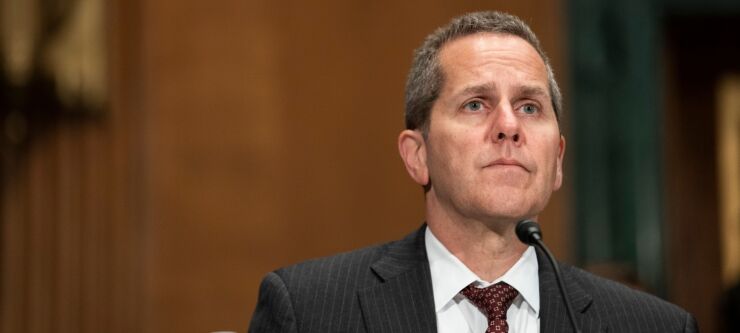
The Federal Reserve's top regulator will lead a probe of its supervision activity that preceded the second-largest bank failure in U.S. history, the central bank announced Monday.
Fed Vice Chair for Supervision Michael Barr will conduct a review of the regulation and supervision activity applied to Santa Clara, Calif.-based Silicon Valley Bank, which was shut down by state regulators and taken over by the Federal Deposit Insurance Corp. last week.
The Fed was the primary regulator for the $209 billion state-chartered member bank, which was shuttered after a blistering
In a statement, Fed Chair Jerome Powell said the events surrounding the bank's swift demise "demand a thorough, transparent, and swift review." The Fed will publish Barr's findings by May 1, the Fed noted in a press release.
In the days since Silicon Valley Bank's failure, the FDIC has
On Monday morning,
Some industry participants, policy experts and scholars have pointed the finger at the Fed for failing to address the underlying weaknesses at Silicon Valley Bank, including its heavy reliance on uninsured depositors — those with more than $250,000 at the bank — its exposure to underwater mortgage-backed securities and its failure to hedge against interest rate risks.
Dennis Kelleher, head of the consumer advocacy group Better Markets, said many of the issues at Silicon Valley Bank were clear to outsiders. Because of this, he said, there is no excuse for why the Fed did not pick up on those vulnerabilities and addressed them before the bank was in crisis.
"Short sellers have been circling and tweeting detailed warnings about the bank's 'massive unrealized losses' for months, and with only publicly available information, saw the bank was a ticking 'time bomb sitting in plain sight,'" Kelleher said in a written statement. "The Fed, with its superior inside knowledge and information, should have seen these risks and ordered SVB to take corrective action long before its failure."
Peter Conti-Brown, a professor at the University of Pennsylvania's Wharton School of Business, said failures of Silicon Valley Bank and Signature Bank should be opportunities for bank regulators to reflect on their supervisory and risk management practices. But, he noted, holding those agencies accountable might be best done by an outside source.
"It needs to be done in a way that does not permit the supervisors and regulators to control the narrative of an exogenous shock," Conti-Brown said. "This is just about as endogenous a banking crisis as we have ever seen, going back to the Great Depression."
Conti-Brown said the issues at Silicon Valley Bank amount to financial mismanagement, with the bank taking on too many uninsured depositors — creating a high flight risk — and an overexposure to long-dated securities that have been devalued by recent interest rate hikes. The blame for this mismanagement, he said, lies just as much with the Fed as the banks.
"The place to start focusing on responsibility ought not to be only on the banks, but also on the bank supervisors," he said. "Banks supervisors and banks are partners in risk management, and when risk management fails, especially so spectacularly, that failure belongs to banks and the bank supervisors."
In the months leading up to the past week's failures, bank regulators had warned about liquidity and concentration risks in the banking sector. Many of these warnings were aimed directly at banks that dealt with cryptocurrencies and digital assets, but the volatility of the tech sector — which constituted the majority of Silicon Valley Bank's customer base — was also flagged.
One day before Silicon Valley Bank was shuttered, after delivering a
On Monday, Barr said the failure of Silicon Valley Bank warranted a revisiting of the central bank approach toward overseeing the bank.
"We need to have humility, and conduct a careful and thorough review of how we supervised and regulated this firm, and what we should learn from this experience," Barr said in a written statement.






